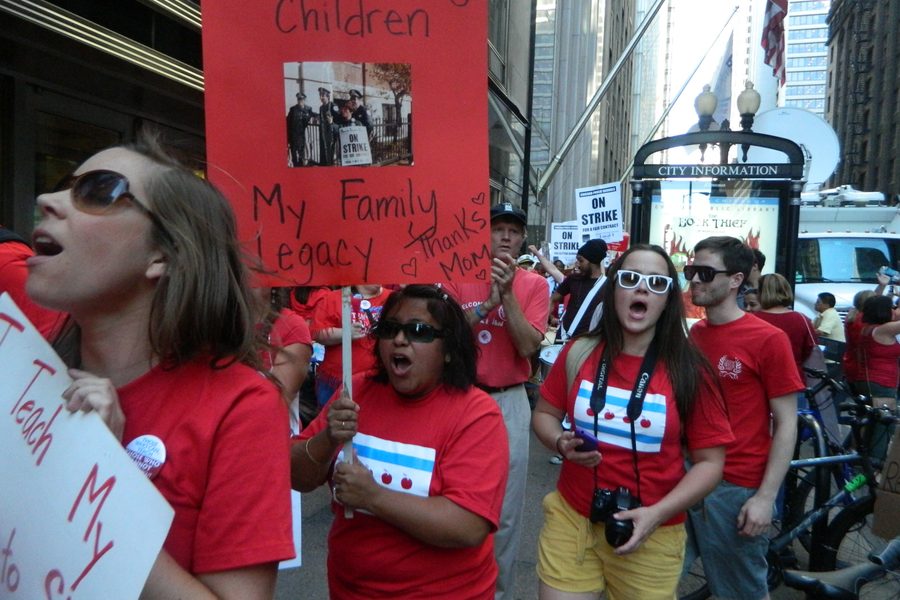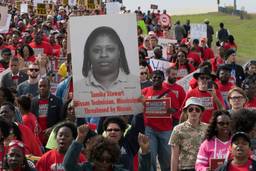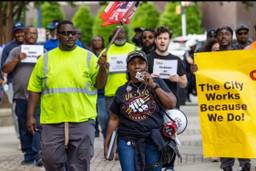
The section of Ashland Avenue running through the Pilsen neighborhood on Chicago’s near southwest side is always noisy. A strip of restaurants, bakeries, hardware stores and other small businesses in the heart of the Mexican immigrant neighborhood is sandwiched between heavily industrial areas and two major highways, so traffic is heavy and loud.
But on September 11, the noise level on Ashland Avenue just east of the Cooper Academy bilingual elementary school became a true cacophony. Horns blared nonstop: from city buses, postal vans, FedEx and UPS trucks, sleek sedans and beat-up pickups loaded with construction equipment or recyclable junk. On the median and the sidewalks — in front of two beauty salons, a locksmith and taquerias — people clad in red T-shirts cheered, yelled, beat drums and strummed guitars.
This was day two of the Chicago Teachers Union (CTU) strike, and teachers, parents and community members were out in force. They marched in front of the school, decorated with tile mosaics of Latino resistance fighters from the Aztec days to the Mexican Revolution to modern-day labor leaders like Cesar Chavez and Dolores Huerta. They chanted in English and Spanish and carried homemade bilingual picket signs.
In the rancorous lead-up to the strike, both the union and the city administration have tried to paint the other party as insensitive to the needs of children and families and claim that the public is on their side. The turnout at Cooper — like those at other schools around the city Monday and Tuesday — suggests heavy local support for striking teachers. Many parents joined the picket line, often with children in tow in strollers or cavorting on bikes.
Cooper is one of the about 140 schools where the Board of Education is spending up to $25 million to provide a safe space and food for students, though under labor law nothing classified as teaching can occur. Seemingly few parents wanted to cross the picket line to bring their kids to the alternative programming being held at the school. Students from at least six different schools were eligible for the programming at Cooper, but a union organizer said fewer than 20 students went through the school’s doors on Monday and Tuesday combined. Citywide, results were similar.
“Parents are getting the message that it’s not a good idea to bring their students here without us,” said a teacher helping to lead the picket.
Parents and Teachers
Colleen Herman, the Cooper school librarian and a Chicago Public Schools (CPS) parent, noted that while the city administration has tried to divide teachers and parents, many CPS teachers are in fact also parents themselves.
“We’re required to live within the city limits, and most of us don’t have the money to send our kids to Catholic schools,” she said, noting that her daughter’s class at a public school on the north side has 33 kids in it. Herman and some of her neighbors have organized a “strike school” with a different parent each day organizing activities for the group. While teachers almost unanimously say they are sorry students are missing class, some point out that the strike also provides a first-hand civics lesson.
Herman explained to her young daughter that two sides are trying to come to an agreement in the best interest of students. She said her daughter burst into tears worried that the teachers were feuding with the principal.
Herman said she thinks there’s much public misunderstanding of some of the key issues being negotiated, including the question of what happens to teachers laid off at closed “failing” schools.
The union has insisted those teachers get first recall rights. As of Tuesday, the city administration was reportedly only offering an interview with another principal but no job security guarantees. Herman noted that schools in low-income and immigrant neighborhoods are disproportionately more likely to be deemed “failing” despite the best efforts of teachers and students.
“They make it sound like these are teachers being laid off because they are bad teachers,” she said. “If there is merit pay, why wouldn’t I go to a different school” where students are more likely to score well, she noted. [The administration has backed off plans for merit pay, but merit-based evaluations are still on the table.]
After picketing until 10:30 a.m. — which included a moment of silence for the anniversary of the September 11 attacks — many teachers and supporters from Cooper headed downtown for the second consecutive mass rally outside the Board of Education headquarters. Teachers in red t-shirts streamed toward the board building from all directions, and when union president Karen Lewis appeared on the street a few blocks from the board office, she was surrounded by giddy protesters snapping photos with their cell phones and jostling to hug and congratulate her.
Addressing thousands of teachers and other protesters soon after, she said, “These are their policies, not ours. When these policies failed, who did they blame?” “Us!” the crowd thundered.
Education and Mental Health
Before the afternoon’s rally members of the Mental Health Movement, a grassroots initiative protesting the closing of six public mental health clinics, joined with CTU social workers and teachers outside the mayor’s office in City Hall. They demanded that rather than cutting staff at unionized schools, the administration should hire more counselors and other mental health professionals. According to two school social workers who spoke at the rally, there are only 370 counselors for 400,000 students and most counselors move between multiple schools in the course of a day.
“Social work services take place in old bathrooms, in hallways, in dingy closets,” said David Temkin, a CPS social worker for 14 years. “How would Mayor Emanuel feel if the only therapy he had was held in one of these locations? How would he feel if it was his child?”
He noted that New Trier High School in the wealthy northern suburbs, where Emanuel went to school, employed 15 counselors and social workers for about 3,000 students — a one to 200 ratio compared to CPS’s ratio of about one to 1,000.
Mental Health Movement activist Jesus Campuzano described how school social workers were key to his education and even survival.
“I’m a former CPS special ed student,” he said. “I know the importance of having a social worker by your side. If I didn’t have my social worker, I wouldn’t be here right now. There were times I felt depressed, down, sometimes I even felt like killing myself. If Rahm Emanuel really cared, he would open more mental health clinics in our communities and hire more social workers in the schools. I live in a ‘bad area,’ I don’t deny it. But that’s not going to stop me. The Mental Health Movement supports the social workers and their strike.”
Union Support
Later Tuesday afternoon, outside the Board of Education, other labor leaders including SEIU Local 1 President Tom Balanoff, Chicago Federation of Labor President Jorge Ramirez, American Federation of Teachers President Randi Weingarten, Fraternal Order of Police President Mike Shields, AFSCME 31 President Henry Bayer and Western Region-UE Director Carl Rosen pledged their support for striking teachers. Balanoff said SEIU Local 1 gave the two-days notice required for their members — janitors in the public schools, working for private contractors — to refuse to go to work.
The teachers’ battle is being seen by Chicagoans and people around the country as a battle not only about teacher evaluation, job security and pay but also a referendum on the future of public education and the role of non-union charter schools and for-profit companies.
“They’re looking at it from the business aspect versus the educational aspect, but education is not a business,” says Sabrina Coulter, a CTU member and school nurse for the past three and a half years, who noted that school nurses usually cover up to six different schools.
Herman says she’s been frustrated with statements from the mayor’s office and media reports that she thinks make it look like Emanuel wants to distance himself from the teachers and the strike.
“It’s like he doesn’t want to dirty his hands with it, he keeps saying ‘they should work it out,’” she says.
But at the downtown rally there was no doubt people blame the mayor and schools CEO Jean-Claude Brizard. “This strike was approved by Rahm Emanuel,” read one sign.
“What Rahm wants: test-taking factories, outsource public education to private charters, close 100 schools,” read another.
Another read simply: “The Revolution will not be Standardized.”

I hope you found this article important. Before you leave, I want to ask you to consider supporting our work with a donation. In These Times needs readers like you to help sustain our mission. We don’t depend on—or want—corporate advertising or deep-pocketed billionaires to fund our journalism. We’re supported by you, the reader, so we can focus on covering the issues that matter most to the progressive movement without fear or compromise.
Our work isn’t hidden behind a paywall because of people like you who support our journalism. We want to keep it that way. If you value the work we do and the movements we cover, please consider donating to In These Times.
David Moberg, a former senior editor of In These Times, was on staff with the magazine from when it began publishing in 1976 until his passing in July 2022. Before joining In These Times, he completed his work for a Ph.D. in anthropology at the University of Chicago and worked for Newsweek. He received fellowships from the John D. and Catherine T. MacArthur Foundation and the Nation Institute for research on the new global economy.







